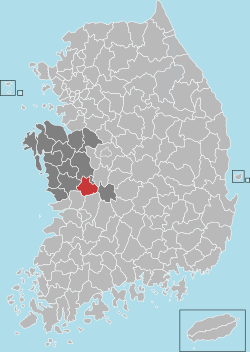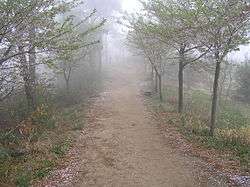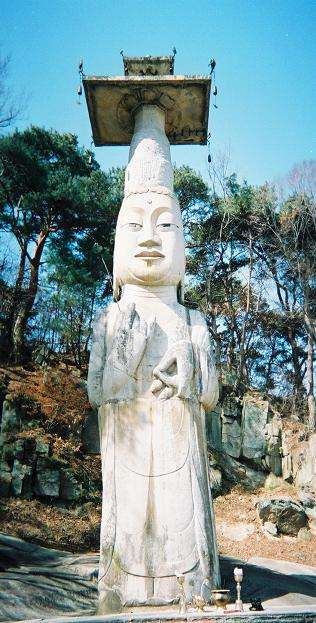Nonsan
| Nonsan 논산시 | ||
|---|---|---|
| Municipal City | ||
| Korean transcription(s) | ||
| • Hangul | 논산시 | |
| • Hanja | 論山市 | |
| • Revised Romanization | Nonsan-si | |
| • McCune-Reischauer | Nonsan-si | |
| ||
 Location in South Korea | ||
| Country |
| |
| Region | Hoseo | |
| Administrative divisions | 2 eup, 11 myeon, and 2 dong | |
| Government | ||
| • Mayor | Lim Sung-kyu | |
| Area | ||
| • Total | 554.82 km2 (214.22 sq mi) | |
| Population (2003) | ||
| • Total | 136,356 | |
| • Density | 246/km2 (640/sq mi) | |
| • Dialect | Chungcheong | |

Nonsan is a city in South Chungcheong Province, South Korea. It is located at 36°12′N 127°5′E / 36.200°N 127.083°E. Nonsan is also called Nolmoi, meaning dusk(y) or yellow mountain ; "Nonsan" means rice paddies + mountain(s).
History
Nonsan has a significant history.[1] During the Samhan period, Nonsan is believed to have been part of Mahan territory. In the Baekje period, the district belonged to Hwangdeungyasan-gun. The crucial battle in which Silla defeated Baekje is thought to have taken place in the general area of Nonsan. Later, in the Silla period, Nonsan was divided into two different towns: Deogeun and Hwangsan.
The train station was built in 1911, in the same year as the rail line through the Nonsan plain was completed.[2]
The modern city of Nonsan was established in 1914, by the merger of the four counties of Yeonsan-gun, Eunjin-gun, Noseong-gun and Seoksung-gun.
During the Korean War, a POW camp was set up by the U.S. and South Korean forces. On June 18, 1953, at the Nonsan camp as well as at POW camps at Busan, Masan, and Kwangju, thousands of POWs swarmed out of the camps and melted into the local population in order to avoid being repatriated to North Korea.[3]
Transportation
Nonsan is served by the national railroad system and city, regional and national bus lines. An expressway connects the city to Daejeon and other cities. Many streets have bike paths, sharing pavement with sidewalks. The stream running through the city proper is not navigable, but downstream it joins the Geum River, and an outlying subdivision of the city serves as a significant fishing port.
Economics and industry
Nonsan is an agricultural city, with rice being the most important crop. Other important crops include strawberries, ginseng, napa cabbage,[4] watermelons,[4] and Korean pears. According to The Chosun Ilbo,[5] the farmers are growing new varieties of strawberry produced in Japan without the producer's permission, while the JoongAng Daily says "Strawberries grown in Nonsan are of various types: seolhyang, maehyang, geumhyang, janghi (akihime) and yukbo (red pearl). The first three were developed in Nonsan while the latter two are from Japan. Janghi is the most commonly grown in Korea. However, seolhyang is the sweetest".[6] Sesil [pronounced "say -shill"] company is the world's third leading producer of insects for natural pest control. The prominent yogurt company, Yakult, has its headquarters in Nonsan. Agro-Fisheries Trade Corp. is a regional supplier of food products.[4]
The greater Nonsan area includes the ROK Army training center (36°07′32″N 127°06′24″E / 36.125483°N 127.106697°E).
Education
Higher education
- Konyang University,건양대학교 홈페이지 founded 1991, has its main campus in Nonsan. It has a university hospital with educational programs for medical technicians, nurses and doctors in Daejeon
- Hanmin University,한민학교 홈페이지 in Yeonsan-myeon
- Geumgang University,금강대학교 홈페이지 a recently founded Buddhist university, in rural Nonsan, near Gyeryongsan
- Korea Bio Polytechnic, 한국폴리텍특성화대학 바이오캠퍼스 홈페이지 is a two-year college run by the nation's Department of Labor.
Secondary education
Nonsan has a number of high schools, including a girls' high school, a technical high school, and two private schools which attract students from across the province and beyond. 쌘뽈여자고등학교 홈페이지
Tourism
Local attractions include the Eunjin Mireuk, a large standing Buddhist sculpture of the Goryeo period and its accompanying temple, Gwanchoksa,[7] as well as the Baekje Military Museum 백제 군사 박물관.
 Mireuk-bosal at Gwanchok Temple in Nonsan City, South Chungcheong Province, South Korea
Mireuk-bosal at Gwanchok Temple in Nonsan City, South Chungcheong Province, South Korea
The spring Strawberry Festival [8] is popular tourist event as is the Ganggyoung autumn fermented seafood festival.[9]
The eight famous spots in Nonsan include Gwanchoksa, the historic sites of General Gyebaek, Tapjeong Reservoir, Ssanggyesa (Temple), and Noseong Sanseong (Fortress).[10][11][12]
Other
The city has a concert hall, where various cultural activities such as concerts and lectures are held. Konyang University's auditorium also hosts free cultural activities for the community.
In June 2011, the multipurpose culture hall Sangsang Madang was completed. It is dedicated to "indie art".[13][14]
Donam Academy, one of the nine neo-Confucian seowon established in Korea during the Choseon dynasty, is in greater Nonsan. It was made a UNESCO provisional world heritage site in December 2011.[15]
Administrative divisions
Nonsan City has jurisdiction over 2 eup, 11 myeon, and 2 dong.
| Name | Hangul | Hanja |
|---|---|---|
| Ganggeyong-eup | 강경읍 | 江景邑 |
| Yeonmu-eup | 연무읍 | 鍊武邑 |
| Seongdong-myeon | 성동면 | 城東面 |
| Gwangseok-myeon | 광석면 | 光石面 |
| Noseong-myeon | 노성면 | 魯城面 |
| Sangwol-myeon | 상월면 | 上月面 |
| Bujeok-myeon | 부적면 | 夫赤面 |
| Yeonsan-myeon | 연산면 | 連山面 |
| Beolgok-myeon | 벌곡면 | 伐谷面 |
| Yangcheon-myeon | 양촌면 | 陽村面 |
| Gayagok-myeon | 가야곡면 | 可也谷面 |
| Eunjin-myeon | 은진면 | 恩津面 |
| Chae-un-myeon | 채운면 | 彩雲面 |
| Chwiam-dong | 취암동 | 鷲岩洞 |
| Buchang-dong | 부창동 | 富倉洞 |
Sister cities
Notable people
- Hwang Myung-Sun, he is a mayor of Nonsan city.
- Lim Sung-kyu, South Korean Minister of Finance and Economy
- Noh Sang-Kyoon, contemporary artist [16]
- Rhee In-je, three-time South Korean presidential candidate, was born in Nonsan.[17][18]
- Chun Sung-gwan, Head of the Seoul Central District Prosecutor's Office (2009)[19]
- Yeom Hong-chul, Mayor of Daejeon[20]
- Go Soo, film and television actor was born in Nonsan.
- Park Beom-shin, writer, is from Nonsan.
- Kim heo-soo, a university president in konyang university and konyangcyber university
- Choi Hyeon-soo, The dean of CICS(College of Interdisciplinary & Creative Studies in Konyang University 창의융합대학)
See also
References
- ↑ 눈산의 어제이야기, Nonsan Moon-hoa ueon: Nonsan Naedong, 2007.
- ↑ Grager, Edwin H. (1994). (Questia - pay for view) Landownership under Colonial Rule: Korea's Japanese Experience, 1900-1935 Check
|url=value (help). University of Hawaii Press. p. 195. Retrieved 2014-12-02. - ↑ Lee, Bong (2003). (pay site) The Unfinished War: Korea Check
|url=value (help). new York: Algora. p. 222. Retrieved 2014-12-02. - 1 2 3
- ↑ (Japanese) http://japanese.chosun.com/site/data/html_dir/2005/03/22/20050322000063.html
- ↑ Limb Jae-un "Let Me Take You down to Nonsan," February 16, 2007
- ↑ http://english.nonsan.go.kr/nsforeign/english/sub_frame.jsp?menu=03&sub=01&third=. Retrieved March 22, 2009. Missing or empty
|title=(help) - ↑ http://english.visitkorea.or.kr/enu/SI/SI_EN_3_2_2.jsp?cat=1&area&dateStart=03-01-2009&startDate=20090301&dateEnd&endDate&keyword&category&areaCode&gotoPage&stype&cid=708055
- ↑ http://ggfestival.co.kr
- ↑ http://nonsan.grandculture.net/Contents/Index?contents_id=GC02000550
- ↑ http://tour.nonsan.go.kr
- ↑ "Nonsan". Retrieved 2014-12-02.
- ↑ Archived June 13, 2011, at the Wayback Machine.
- ↑ "KT&G 상상마당". Sangsangmadang.com. Retrieved 2013-05-13.
- ↑ accessed 2012.04.19
- ↑ Ignacio Villarreal (2011-05-01). "Solo Exhibition of Korean Artist Noh, Sang-Kyoon at Bryce Wolkowitz Gallery". Artdaily.org. Retrieved 2013-05-13.
- ↑ (Korean) "Can Minor Candidates Become Major Leaguers," Korea Times online November 21, 2007: https://www.koreatimes.co.kr/www/news/nation/2007/11/113_14066.html Archived February 1, 2014, at the Wayback Machine.
- ↑ INSIDE JoongAng Daily
- ↑ JoongAng Daily online, 22 June 2009 http://joongangdaily.joins.com/article/view.asp?aid=2906411
- ↑ "Profiles of Winners". Koreatimes.co.kr. 2010-06-02. Retrieved 2013-05-13.
External links
- Official government website
- Government site for foreginers: http://english.nonsan.go.kr/nsforeign/user.tdf?a=user.index.IndexApp&c=6002

